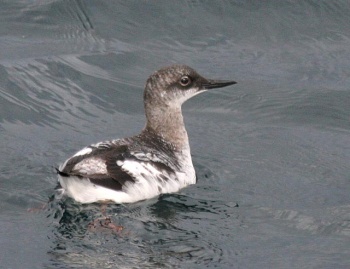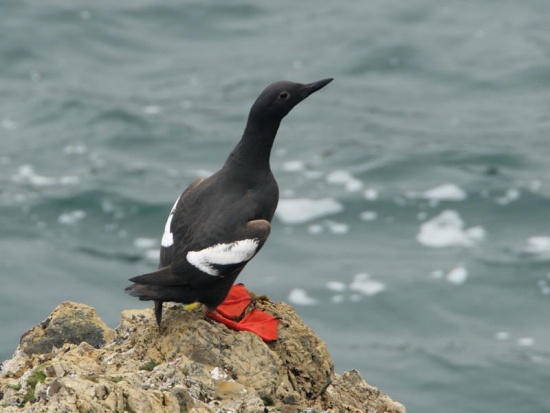- Cepphus columba
Identification
Length 33-35cm (13-14in).
A mostly black bird with a prominent white wing patch bisected by a black bar or wedge. The webbed feet and legs are bright reddish-orange. The body is tapered for underwater swimming prowess, and terminates in a long, thin, black bill. In flight, the underwings and axillaries can be seen to be dusky gray.
Winter birds are white underneath and mottled gray above.
Juveniles are similar to winter adults but white wing panel reduced to white tips.
Variations
Aleutian populations average more white in their wing. They are also have shorter bills but longer wings cf. populations further south into coastal California. Subspecies C. c. snowi has much reduced white in wing. It is sometimes recognized as a separate species.
Similar Species
Black Guillemot has white underwings in all plumages. Subspecies C. c. snowi in winter resemble winter Spectacled Guillemot, but lack the white eyering.
Distribution
Pacific coast of North America from Alaska to California. (see Taxonomy section)
Taxonomy

Photo © by Glen Tepke
Monterey Bay, Monterey County, California, USA, 27 December 2004
Subspecies[1]
Five subspecies are recognized:
- C. c. columba:
- C. c. snowi:
- Kuril Islands
- C. c. kairuka:
- Komandorskiye Island to west-central Aleutians
- C. c adiantus:
- Central Aleutians to Washington
- C. c. eureka:
Habitat
Rocky shores, cliffs and islands.
Behaviour
Actions
Swims underwater in pursuit of food using its wings. Gathers small fish near the ocean bottom.
Breeding
Nests are made in rocky cavities. The clutch consists of 2 eggs.
Diet
Includes fish and other aquatic animals.
Movements
Spring and autumn migrations poorly known, as are details of winter range. Generally winters at sea. Southernmost breeding populations apparently move north in the winter.
References
- Clements, J. F., T. S. Schulenberg, M. J. Iliff, S. M. Billerman, T. A. Fredericks, B. L. Sullivan, and C. L. Wood. 2019. The eBird/Clements Checklist of Birds of the World: v2019. Downloaded from http://www.birds.cornell.edu/clementschecklist/download/
- Wikipedia contributors. (2020, January 1). Pigeon guillemot. In Wikipedia, The Free Encyclopedia. Retrieved 07:47, March 28, 2020, from https://en.wikipedia.org/w/index.php?title=Pigeon_guillemot&oldid=933584929
- Ewins, P. J. (2020). Pigeon Guillemot (Cepphus columba), version 1.0. In Birds of the World (A. F. Poole and F. B. Gill, Editors). Cornell Lab of Ornithology, Ithaca, NY, USA. https://doi.org/10.2173/bow.piggui.01
- Nettleship, D.N., Boesman, P. & Garcia, E.F.J. (2020). Pigeon Guillemot (Cepphus columba). In: del Hoyo, J., Elliott, A., Sargatal, J., Christie, D.A. & de Juana, E. (eds.). Handbook of the Birds of the World Alive. Lynx Edicions, Barcelona. (retrieved from https://www.hbw.com/node/54064 on 28 March 2020).
Recommended Citation
- BirdForum Opus contributors. (2024) Pigeon Guillemot. In: BirdForum, the forum for wild birds and birding. Retrieved 28 April 2024 from https://www.birdforum.net/opus/Pigeon_Guillemot
External Links
GSearch checked for 2020 platform.






